Tags
dragons, norwich cathedral, snap the dragon, St George and the dragon, Stained Glass, The Tudors
To the medieval mind dragons stood as a metaphor for the devil and all his works, the origin of pestilence and plague. The concept of a dragon could have evolved from travellers’ tales about fabulous beasts or even fossils. In one incarnation, dragons were represented as giant worms – indeed, the Old English for dragon is wyrm (or Old High German, wurm). A beautiful manifestation of the worm-like dragon is to be seen on the C13th infirmary doors from Norwich Cathedral, now in Norwich Castle.

Norwich Castle Museum and Art Gallery
The more familiar version is of a four-legged, bat-winged creature usually seen writhing at the end of St George’s lance or St Michael’s sword. The fable of St George and the Dragon is thought to have originated in the east and brought back to this country following the crusades. St George is usually represented as a knight on horseback as can still (just about) be seen in this C14th carving from Ragusa, Sicily.
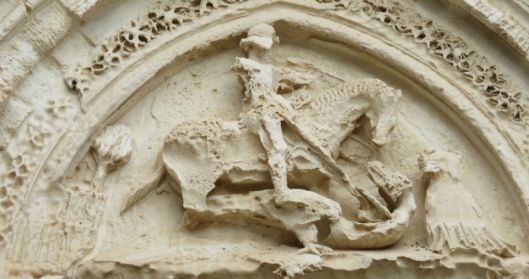
Dragons feature strongly in Norwich’s history. St George is the city’s patron and the Guild of St George, founded in 1385 [1], became a prominent social institution, celebrating the saint’s feast day and performing acts of charity for its members and the needy. In 1417 the power of the guild was greatly enhanced when it was granted a Royal Charter by Henry V, perhaps in recognition of its members who fought alongside him at Agincourt. In 1548 the guild lost its religious basis, transforming itself into the secular Company of St George that celebrated the arrival of the new mayor. However, the dragon still took part in non-religious processions; it was first mentioned as taking part in 1408, it survived Puritanism then became a civic player, performing in annual guild days when the mayor was inaugurated.

Snap the Dragon at Norwich Castle Museum and Art Gallery
Taunted by the chanting crowd the dragon would grab caps in its jaws, ransoming the headwear for a penny.
“Snap, Snap, steal a boy’s cap, give him a penny and he’ll give it back”
This C19th engraving gives a sense of the raucous nature of the guild day.

In the marketplace, outside the extant Sir Garnet (Wolseley )pub. (c) Picture Norfolk at Norfolk County Council
Although much of the pageantry disappeared after the passing of the Municipal Corporation Reform Act of 1835 it survived in mock pageants held in the district of Pockthorpe and in the nearby village of Costessey [1]. This 1887 photograph of the Costessey guild day nicely captures the flummery that accompanied the election of the ‘mayor’.
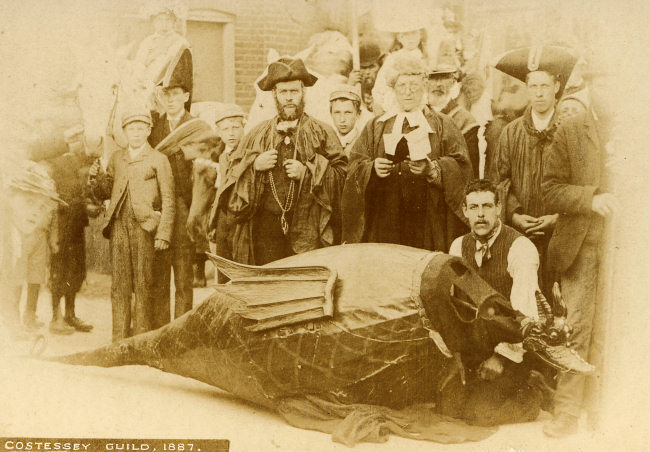
(c) Picture Norfolk at Norwich County Council
In 1951, Snap the Dragon was still being used in civic parades and is seen here accompanied by two whifflers (from Old English wifel for battle-axe) who, historically, carried weapons to clear the way through the crowd. The photograph is believed to be of the Pockthorpe Dragon, now stored by Norfolk Museums Service [2]
![Festival procession snapdragon and whiffler [4008] 1951-06-24.jpg](https://colonelunthanksnorwich.com/wp-content/uploads/2016/10/festival-procession-snapdragon-and-whiffler-4008-1951-06-24.jpg?w=529)
(c) georgeplunkett.co.uk

Probably the most famous Norwich dragon is to be found in Dragon Hall. In ca 1427, on the site of a previous building, wealthy textile merchant Robert Toppes [4] constructed a trading hall then known by the wonderful name, Splytts. Three-times mayor Toppes was member of the St George’s Guild, a fact celebrated in the beautifully-carved winged dragon in a roof spandrel.

Three pairs of dragons are to be found in the refectory roof of the Great Hospital, near the cathedral. The hospital has continuously provided for the needy since 1249, when it was built by Bishop Walter de Suffield to care for poor clergy, and is now a residential care home.

Also in the Great Hospital, in St Helen’s Church, is a fine example of the devil as the dragon. The dragon is said to have swallowed St Margaret of Antioch but her cross irritated the dragon, allowing her to break free. Here she is shown on a medieval pew end emerging from the dragon’s belly, illustrating her role as the patron saint of pregnancy and childbirth.
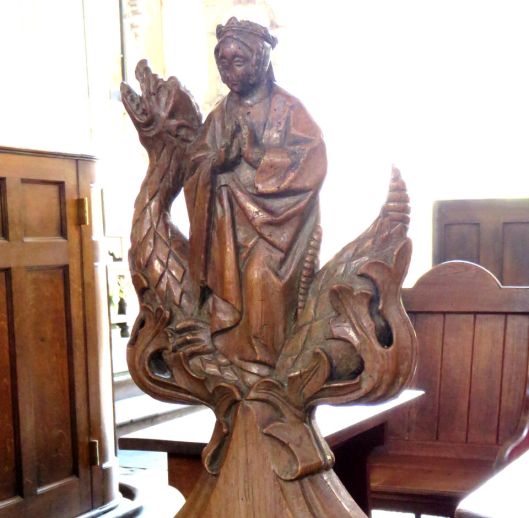
On St Ethelbert’s Gate of the nearby cathedral is another spandrel dragon, restored in the C19th. The dragon, facing an armed man/saint on the opposite side of the arch, may allude to a bloody C13th conflict between clergy and citizens for which 30 rioters were hanged [5]

Norwich Cathedral contains over 1100 roof bosses carved in stone: this boss is from the cloisters [6]. The swordsman’s nonchalant gaze could almost come from a piece-to-camera on how to kill a dragon.
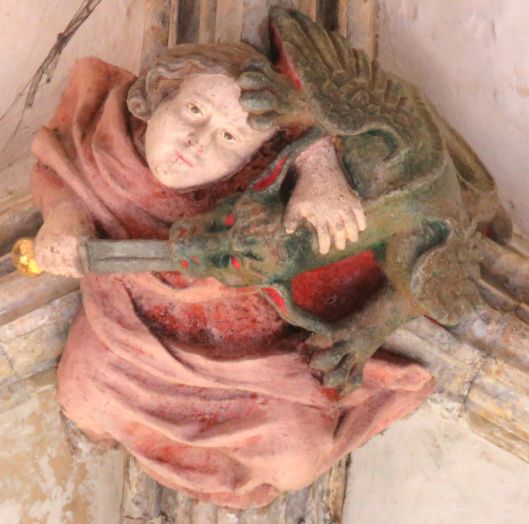
C14th, Cloisters, Norwich Cathedral
Only yards away a rampant dragon appears amongst a series of coats of arms painted in the arches of the cloisters (restored in the 1930s). These represent the worthies who entertained Queen Elizabeth I during her progress to Norwich in 1578. The arms below belong to the queen herself and incorporate the lion of England and the dragon of Wales derived from her grandfather Henry Tudor.
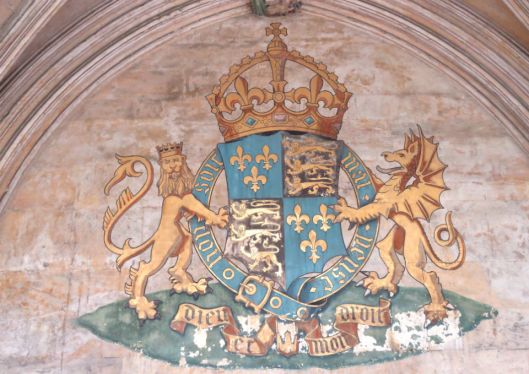
The city’s allegiance to the Tudors is also expressed in the first two of these exuberantly-carved bench ends in the Mayor’s Court of the Guildhall. The greyhound (lower left), with jewelled collar around its neck, represents the Beaufort line of Henry VII’s mother Margaret while the Welsh dragon (centre) refers to Henry Tudor’s Celtic father. And because of its imagination and skill I couldn’t resist adding (right) the greedy dragon from St Agnes Cawston (although the beast would be more frightening if its head were less like a labrador’s).

Visitors to King’s College Chapel Cambridge will be familiar with the dragon and greyhound from the numerous Royal Coat of Arms that Henry Tudor displayed to impress his entitlement to the throne.

St George Tombland contains more dragons than any other Norwich church with the beast rendered in cast bronze, a C16th Germanic relief plaque, a weather vane as a font cover, and even some Snap-the-Dragons. The stained glass window of St George and the Dragon is by CC Powell 1907.

Here is one of Norfolk’s treasures, St George wielding a sword to vanquish the dragon; from the rood screen at St Helen Ranworth (late C15th).

… and demonstrating that dragons are still alive in the city of dragons.
Should twenty thousand dragons rise, I’d fight them all before your eyes!
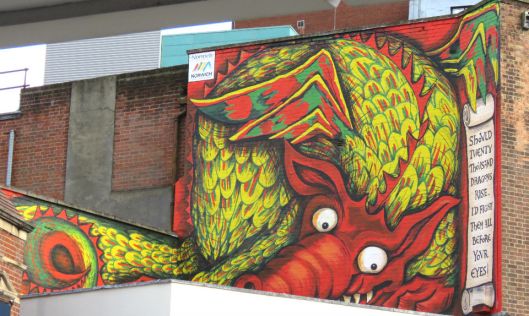
By Malca Schotten, 2016. Based on Snap, part of Norwich BID’s mural programme. Red Lion Street
Thanks to David Kingsley for the Back’s ‘Snap’ advertisement, to Clare Everitt of Picture Norfolk at Norfolk County Council for permission to use images, the staff of Norwich Castle Museum and Art Gallery for showing me their dragons, and Jumara Mulcahy of Norwich BID.
The Norwich Society helps people enjoy and appreciate the history and character of Norwich. Visit: www.thenorwichsociety.org.uk
Sources
- http://www.dragonglow.co.uk/snap.htm
- http://www.nor-folk.co.uk/Norwich%20Dragon/aliens.html
- http://wp.me/p71GjT-3Zt
- http://wp.me/p71GjT-t
- http://wp.me/p71GjT-32e
- Rose, Martial and Hedgecoe, Julia (1997). Stories in Stone: The medieval roof carvings of Norwich Cathedral. Herbert Press.
Read about Norwich’s dragons in http://www.heritagecity.org/events-festivals/norwich-dragon-festival/norwichs-dragons.htm


I was fascinated to read of the dragons portrayed as worms and the origins of the word “dragon”. I wondered if this might also be the origin of the word “wyvern” which is a two legged dragon portrayed on Wesley’s coat of arms and the symbol of my sons’ formerly Methodist school. I have often wondered also why dragons are widespread (such as in Chinese culture in addition to Western cultures) if they were mythical. Thanks for showing us how prevalent dragons are in Norwich and their significance for the city.
LikeLike
I must admit I wasn’t sure about the difference but a quick resort to Google suggests that wyvern (which has a snake-like tail) derives from the Latin vipera – so, again, the ubiquitous’worm’. I did see wyverns in my travels around the city e.g. on the Catholic cathedral. Are you are Norvicensian?
LikeLike
Hi again, no I’m not a Norvicensian but instead a Sydneysider! However I have a keen interest in Norwich as my great great great grandfather married one of the Unthank daughters from Intwood Hall, as did his brother! (That is, two Robberds brothers married two Unthank sisters). William Unthank (1759 – 1837) was my four greats grandfather, and my four greats grandfather on the Robberds side (John Whitaker Robberds 1760 – 1837) was Mayor of Norwich in 1814. I’m a constant reader about Norwich even though I’ve only visited once so far! I really enjoy your blog. I think I wrote to you previously after reading your post on Arts and Crafts movement houses. Best wishes, Pamela.
LikeLike
Hi Pamela,
Of course, I remember the conversation well. I’m still trying to find where Wm Unthank lived. Can you pull family strings?
LikeLike
Reggie:
between Germany and England we say for ‘worm’, in Dutch:
‘worm’ or ‘wurm’.
The ‘u’ is pronounced, more or less, as in ‘but’.
It always amazes me that in the far east dragons symbolize good luck and happiness.
As always an enjoyable blog: thanks again!
LikeLike
Hi Eva, Does worm or snake appear in the Dutch sense of the word ‘dragon’? Reggie
LikeLike
Very enjoyable post – thank-you! I went to visit St Gregory’s church Pottergate this summer and saw the fresco of St George and the Dragon there. I still haven’t been able to see the dragon in Dragon Hall.
LikeLike
Thank you Clare. I wasn’t able to photograph the St Gregory’s mural very well – pity, since it’s a wonderful medieval piece. It is not easy getting into Dragon Hall now that it’s the Writers’ Centre but next time you come north try getting in to The Great Hospital with SIX dragons in the spandrels.
LikeLiked by 1 person
I will! Thank-you.
LikeLike
Dear Reggie, Thank you for the nice dragons. I like the ones best which are cleverly fitted into the awkward shape of spandrels. Heide
>
LikeLike
Me too. There is a terrific spandrel dragon at Cawston but I was running out of space. I would have liked to have seen the spandrel dragon in St Ethelbert’s Gate at Norwich Cathedral before it was restored.
LikeLike
Dear Reggie, One of your very best – thank you! Heather
LikeLike
Thank you Heather. Reggie
LikeLike
I didn’t realise how many dragons are out there! Thanks Reggie
LikeLike
And they’re breeding like whatsits’ teeth. Hi Theo.
LikeLike
I love this post! We live by the city wall in Norwich and have a very sweet park nearby in Rose Yard. It is decorated by a graffiti artist and has a super Dragon painted on the end of a terrace. It’s a perfect complement to an architecturally mixed, historical and urban area. We will be forever looking for dragons now, thanks Reggie!
LikeLike
fascinating – have photographed St George, St Michael and St Margaret and their dragons all over the world but didn’t realise there were so many on my doorstep i.e. Norwich. Went to Ranworth because of your post the other day
LikeLike
Isn’t Ranworth a treat? Like you, I couldn’t believe there were so many dragons in and around Norwich. Could be the influence of the Guild of St George. I’m pleased the post found a use. Reggie.
LikeLike
Just joining late to your wonderful site – don’t forget St Margaret and the dragon at the church at Felbrigg Hall. It may be a little far for you Norwich folk but a lot closer than Sicily and in better condition!
LikeLike
Sadly, the colonel doesn’t get out much beyond the ring road (apart from the odd pilgrimage to Sicily etc). Thank you for joining, Jon, and for the reminder about the Margaret of Antioch statue at Felbrigg. Best wishes, Reggie
LikeLike